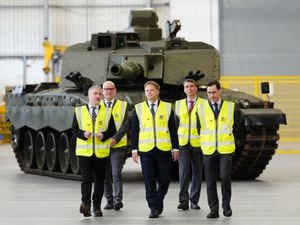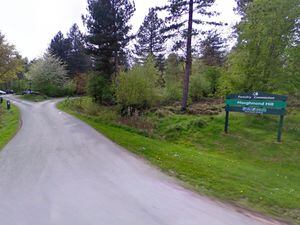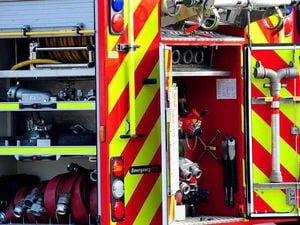Can you solve mystery of lost Shropshire war film
Twisting and turning in the skies, these biplanes were the stars of a movie created by some of the greatest talents of the golden age of cinema, bringing home the drama and heroism of an epic and largely forgotten aerial battle.
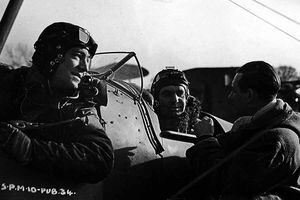
Based at a Shropshire airfield, the film crew overcame technical challenges and unexpected dangers – such as being fired at by friendly anti-aircraft artillery – to shoot spectacular aerial footage.
And almost 75 years later, one of those movie stars has made a return to Shropshire, looking as good as new. It is Gloster Gladiator serial number K8042, one of a number of biplanes that were used in the making of the movie Signed With Their Honour. It is a recent arrival at the RAF Museum at Cosford.
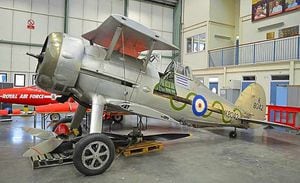
Signed With Their Honour was based on a book of that name by Australian war correspondent James Aldridge, which told the story of the air war in Greece in 1941, when a handful of outdated Gloster Gladiators fought the might of the Luftwaffe in a six week delaying action until the single British squadron was wiped out.
To take part in the movie, experienced RAF pilots were given a "rest holiday" after two or three years' of continuous operational flying. Among them was a decorated Gladiator pilot who had been in the thick of the battle during the Greece campaign.
For taking to the skies above Shropshire and Mid Wales to recreate the aerial conflict, they received no extra pay, the filming all being considered part of their rest cure.
What a fitting backdrop that footage would make for the Gladiator now on display at Cosford, having been moved there from the RAF Museum in London.
Alas, there is a great, unsolved mystery. For after the aerial scenes were in the can, filming was cancelled indefinitely. The movie was never finished and nobody knows what happened to the footage that was shot by the team which had arrived at RAF Rednal, a Spitfire training base near Oswestry, in the autumn of 1943.
Maybe it lies undiscovered in some archive or private collection. Or maybe, and perhaps most probably, it was binned, and has been lost forever.
Can you solve the mystery of the missing film? Email toby.neal@shropshirestar.co.uk
We can however bring you some rare images taken during the filming, which are in an album which was compiled by the cameraman on the project, the late Osmond Borradaile.
"Bordie" was a renowned cinematographer who worked on films such as The Four Feathers and Scott of the Antarctic, and enhanced the work of the likes of Cecil B. De Mille, Alfred Hitchcock, and Otto Preminger. He has been described as "the greatest exterior camera artist in the world."
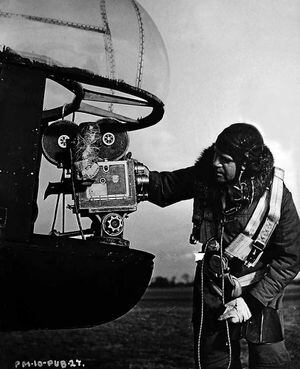
A Canadian, his son George lives in Surrey, British Columbia, Canada, and has kindly emailed us his father's photographic souvenirs of that Shropshire shoot. It is conceivable that they include a photo of K8042, the Gladiator now at Cosford, although with the serial number not visible in some shots, it is impossible to be sure.
Bordie also wrote memoirs – they were compiled into the book "Life Through A Lens" by his daughter Anita Hadley – which shed light on why the film was abandoned.
An ambitious project, to his deep disappointment it ultimately fell victim to the limited resources of the day, he wrote, and he did not know what had happened to the negatives.
Neither George nor Anita, who lives at Victoria, British Columbia, can shed any more light on what happened to the completed footage.
The Air Ministry had given Denham Studios the green light to make the film and co-operated by providing facilities, including aircraft and pilots.
Locations around Shrewsbury were selected, with studio models built at Denham.
The producer was Paul Soskin, the director was Vernon Sewell, and the cast of "resting" RAF pilots included Squadron Leader Richard Acworth, who had won the Distinguished Flying Cross and had taken part in the original air battle over Greece, and another DFC winner, Birmingham-born Flying Officer Tommy Tinsey, who had 52 pieces of shrapnel in his legs, and had flown Spitfires in the North African campaign.
Others included New Zealanders Flight Lieutenant Reg Hyde, an ex-champion dirt track rider and boxer, who was one of the original "Faith, Hope and Charity" fighter pilots during the siege of Malta, and Flying Officer Piggott, a former civil engineer from Auckland, who flew over 100 sorties from Malta.
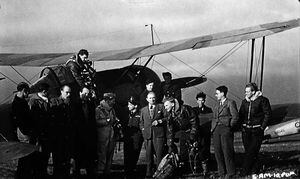
Bordie wrote in his memoirs: "A closely-knit group, the pilots became known as 'Soskin's Squadron' after the producer, Paul Soskin."
He went on: "Our pilots were a grand bunch of fellows. They had all flown at least two tours, and were assigned to us as a rest holiday. Some holiday all right!
"Several of them had actually flown 'Glads' in Greece and Crete, others were fighter pilots since the Battle of Britain days."
Pilot of the Wellington bomber used as a camera plane was a fellow Canadian, George Bain, who later became a newspaper editor in Canada.
The exuberant pilots entered into the spirit of the production, and local townspeople must have wondered, said Bordie, about so many crash dives which left no trace of wreckage. The filming made headlines, and a story in the Daily Express of February 14, 1944, told how "in a market town in the wilds of north west England... country folk run from their cottages day after day to gaze up at the strangest series of aerial dogfights ever seen over Britain..." The town concerned was not mentioned because of censorship, but may well have been Oswestry.
Apart from the Wellington bomber – nicknamed a "Wimpy" – which had cameras in the nose, tail, and midships, two other aircraft were used as camera planes. They were a Tiger Moth two-seater biplane, using a camera swivelled by hand and operated from the open cockpit, and a 1936 Gladiator with an automatic camera clamped onto the lower wing, surrounded by hot water bottles to stop it freezing. A captured Messerschmitt was used as the "enemy."
Bordie wrote: "It did not take long for me to come to the conclusion that this was a most difficult assignment because of all the restrictions imposed on us. We would all be briefed as to the shots we wished to obtain, and warned of the balloon barrage to our east, and told that the ack-ack guns would open up on us if we approached the land from the sea. Well, by the time we got through the clouds and tried to form up to get a shot, we often were over these restricted areas. It was not nice to be fired on by our own guns."
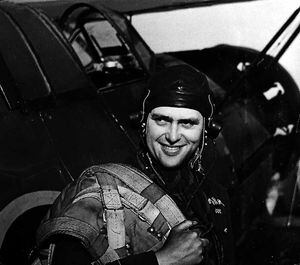
Not long beforehand, Bordie had suffered burns when a ship on which he was filming was sunk in the Mediterranean, and in the low temperatures in the air at 18,000ft his recently-healed burns were very sensitive, so he wore a leather face mask.
"Like the other fellows, I was only glad to get back to our pub and enjoy a grog or two, and of course the laughs that followed.
"We were fortunate, for during all this show, we only lost one Glad, when the pilot made a forced landing in the hospital yard. The pilot did not need the attention of the institute, but the plane was not in such healthy shape.
"Yes, we were indeed lucky. What has happened to the footage, I do not know. A week or so after the air sequences were completed, the production was cancelled for an indefinite time."
The location of this forced landing incident appears to have been Park Hall Farm, Oswestry, on November 4, 1943, so the hospital he mentioned would have been Shropshire Orthopaedic Hospital.
However, Bordie was wrong to think this was the only aircraft to have been lost, as just under three weeks later another two Gladiators were in a mid-air collision near Arddleen in Mid Wales, both pilots baling out.
So what happened, or might have happened, to the completed footage? We went on a sleuthing trail, but ultimately drew a blank.
Tina McFarling of the British Film Institute said there was no straightforward answer to what would happen to uncompleted film.
"If a film was not completed, you have your producers, financiers, and sometimes somebody in the middle called a completion guarantor, who is the intermediary."
Generally it would be one of them who held the completed footage, although it was also possible the footage had been disposed of.
It seems though there is always a hope that it might have survived and unexpectedly turn up.
"The BFI has the biggest archive in the world and we are always discovering new pieces of film and people are bringing film to us, as well as television material.
"Even though a film has not been completed, there is still material value in what has been made."
Our inquiries also took in the Rank Organisation, which turns out to have sold all film rights to Thames TV some time ago; FremantleMedia (of which Thames is now part); British Pathe; and Pinewood Studios, with which Denham Studios had merged many moons ago. Sadly, like all the others, Pinewood could find no trace of the film.
It wasn't deposited at the Imperial War Museum either.
Mr Kay Gladstone, Senior Curator, Film Archive, Acquisitions and Documentation, told us: "This was a commercial – or 'independent' production – so would never have been deposited at IWM, which has only ever acquired for preservation film shot by service or other government-affiliated cameramen."
He added: "In any case the rushes of commercial films which are abandoned are seldom retained, however frustrating that may subsequently be for journalists and historians interested many years later in recalling the past of a certain location."
So, Signed With Their Honour remains "missing," with only a slim hope that this Shropshire movie masterpiece did not end up in the bin.

